It looks like you're using an Ad Blocker.
Please white-list or disable AboveTopSecret.com in your ad-blocking tool.
Thank you.
Some features of ATS will be disabled while you continue to use an ad-blocker.
share:
An epiphany....
You are the Dream-catcher...


and You are the...

A blossoming Lily in an ocean of Self
Facing your own reflections...

How often do you ask yourself

This message is for you this day...

You are the Dream-catcher...


and You are the...

A blossoming Lily in an ocean of Self
Facing your own reflections...

How often do you ask yourself

This message is for you this day...

A Secret Revealed...
That Dream-Catcher is your Sahasrara, the thousand petaled crown chakra.
When your Dreams meet Reality, when you finally catch yourself from this eternal fall, you

Life is just a Metamorphosis from a Caterpillar to a Butterfly, to put it succinctly.

Fortuna Fortuna
You are Master of Your Own Destiny

That Dream-Catcher is your Sahasrara, the thousand petaled crown chakra.
Often referred to as a thousand-petaled lotus, it is said to be the most subtle chakra in the system, relating to pure consciousness, and it is from this chakra that all the other chakras emanate. When a yogi is able to raise his/her kundalini, energy of consciousness, up to this point, the state of Nirvikalpa Samādhi is experienced.
This stage is said to bring about rebirth or the siddhis - powers of transforming into the divine, and being able to do whatever one wishes.
When your Dreams meet Reality, when you finally catch yourself from this eternal fall, you

Life is just a Metamorphosis from a Caterpillar to a Butterfly, to put it succinctly.

Fortuna Fortuna
You are Master of Your Own Destiny

I Dream of Dreams within Dreams...
Nothing is what is seems
Insight, a beam that gleams
We'd make a great team it screams
A vision I've seen with many scenes
Only the keen will know what it all means

Nothing is what is seems
Insight, a beam that gleams
We'd make a great team it screams
A vision I've seen with many scenes
Only the keen will know what it all means

When you achieve Nirvikalpa all thought unifies into 1.
There is no longer a knower, knowing, and that which is known - there is only the Ocean of Spirit.
There is no Darkness, only Enlightenment.
That which is only 1, the Spirit of All, that is your True Self.
This is your Dream.
You wished to gaze at stars from this Earth, did you not?
And what did you discover? That it is

But why would you choose to suffer so profoundly on this Earth?
Because you must know defeat and victory...
You are the

This is the meaning of your

so I advise you to

Because Life is about Sol Awakening via the Crown Chakra and you may also want to check these two links as well, more info and the Rainbow Dreams at Virtual Circle.
It's time to learn about that which is Sacred, the most Occult Arcana of all - Knowledge of your True Self.
Your Universal Identity in this Dream we call Reality.
Unchain your Heart and Mind, Unleash YOU!!

There is no longer a knower, knowing, and that which is known - there is only the Ocean of Spirit.
There is no Darkness, only Enlightenment.
That which is only 1, the Spirit of All, that is your True Self.
This is your Dream.
You wished to gaze at stars from this Earth, did you not?
And what did you discover? That it is

But why would you choose to suffer so profoundly on this Earth?
Because you must know defeat and victory...
You are the

This is the meaning of your

so I advise you to

Because Life is about Sol Awakening via the Crown Chakra and you may also want to check these two links as well, more info and the Rainbow Dreams at Virtual Circle.
It's time to learn about that which is Sacred, the most Occult Arcana of all - Knowledge of your True Self.
Your Universal Identity in this Dream we call Reality.
Unchain your Heart and Mind, Unleash YOU!!

a reply to: muzzleflash

What if my dreams entail smashing my forehead into a keyboard? Would that mean you were enticing violence? Just asking..
I'ts the flu medication talking, probably, maybe, most likely.

What if my dreams entail smashing my forehead into a keyboard? Would that mean you were enticing violence? Just asking..
I'ts the flu medication talking, probably, maybe, most likely.
edit on 13-3-2018 by BotheLumberJack because: (no reason given)
It doesn't mean much
It doesn't mean anything at all
The life I've left behind me
Is a cold room
I've crossed the last line
From where I can't return
Where every step I took in faith
Betrayed me
And led me from my home
Sweet surrender
Is all that I have to give
You take me in
No questions asked
You strip away the ugliness
That surrounds me
Are you an angel
Am I already that gone
I only hope
That I won't disappoint you
When I'm down here
On my knees
Sweet surrender
Is all that I have to give
And I don't understand
By the touch of your hand
I would be the one to fall
I miss the little things
I miss everything, about you
It doesn't mean much
It doesn't mean anything at all
The life I've left behind me
Is a cold room
Sweet surrender
Is all that I have to give
Dream Within a Dream
By: Edgar Allen Poe

Take this kiss upon the brow!
And, in parting from you now,
Thus much let me avow —
You are not wrong, who deem
That my days have been a dream;
Yet if hope has flown away
In a night, or in a day,
In a vision, or in none,
Is it therefore the less gone?
All that we see or seem
Is but a dream within a dream.
I stand amid the roar
Of a surf-tormented shore,
And I hold within my hand
Grains of the golden sand —
How few! yet how they creep
Through my fingers to the deep,
While I weep — while I weep!
O God! Can I not grasp
Them with a tighter clasp?
O God! can I not save
One from the pitiless wave?
Is all that we see or seem
But a dream within a dream?
By: Edgar Allen Poe

Take this kiss upon the brow!
And, in parting from you now,
Thus much let me avow —
You are not wrong, who deem
That my days have been a dream;
Yet if hope has flown away
In a night, or in a day,
In a vision, or in none,
Is it therefore the less gone?
All that we see or seem
Is but a dream within a dream.
I stand amid the roar
Of a surf-tormented shore,
And I hold within my hand
Grains of the golden sand —
How few! yet how they creep
Through my fingers to the deep,
While I weep — while I weep!
O God! Can I not grasp
Them with a tighter clasp?
O God! can I not save
One from the pitiless wave?
Is all that we see or seem
But a dream within a dream?
The Theme of the Dream:

It is both Honorific and

Now you know

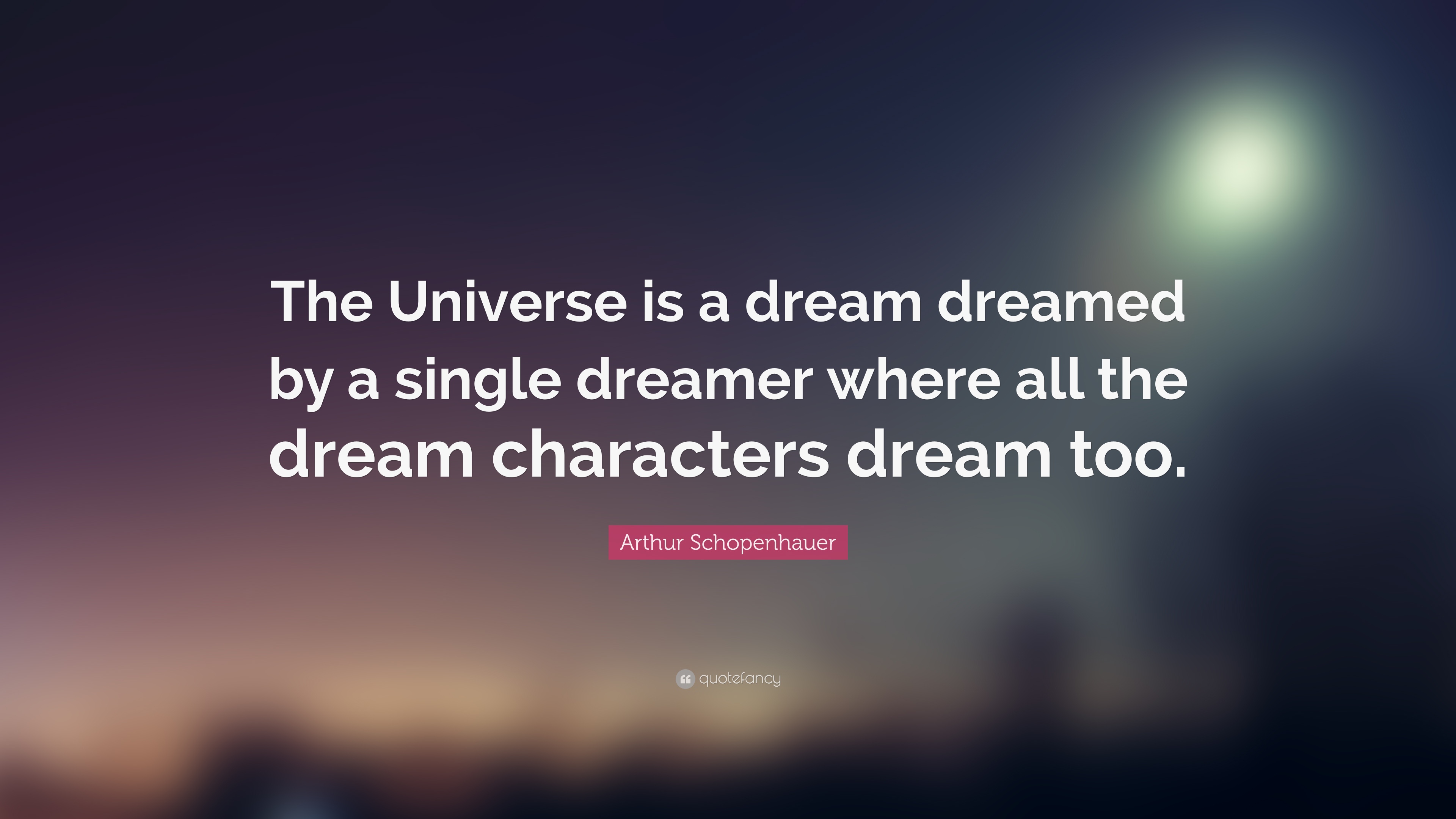
So you better
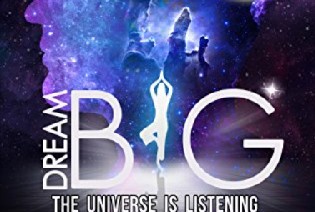

It is both Honorific and

Now you know


So you better

So what am I saying?
That Life is a Lucid Dream, obviously!
Therefore you ought to consciously seek

But where oh where will you find it?
It's right under your nose,
Between the top of your head
and the tips of your toes!

Heed the warnings and wisdom
and be the one who knows...


You must think more

And become

So I'd like you to view this reality as

Revive your inner flower child,
this contradiction must be reconciled,
just let your Heart go wild
your mind must be beguiled
if you ever want your sorrows exiled.

That Life is a Lucid Dream, obviously!
Therefore you ought to consciously seek

But where oh where will you find it?
It's right under your nose,
Between the top of your head
and the tips of your toes!

Heed the warnings and wisdom
and be the one who knows...


You must think more

And become

So I'd like you to view this reality as

Revive your inner flower child,
this contradiction must be reconciled,
just let your Heart go wild
your mind must be beguiled
if you ever want your sorrows exiled.

I come

and propose many

This thread is an 'AV' potion,
I call it a

What we really needed was a

to make our

As Vishnu wish and knew You


"A traditional depiction is Vishnu reclining on the coils of the serpent Shesha, accompanied by his consort Lakshmi, as he "dreams the universe into reality"."


and propose many

This thread is an 'AV' potion,
I call it a

What we really needed was a

to make our

As Vishnu wish and knew You


"A traditional depiction is Vishnu reclining on the coils of the serpent Shesha, accompanied by his consort Lakshmi, as he "dreams the universe into reality"."

Some philosophers have concluded that what we think of as the "real world" could be or is an illusion (an idea known as the skeptical hypothesis about ontology).
The first recorded mention of the idea was by Zhuangzi, and it is also discussed in Hinduism, which makes extensive use of the argument in its writings.[31] It was formally introduced to Western philosophy by Descartes in the 17th century in his Meditations on First Philosophy.
The Dream Argument
While people dream, they usually do not realize they are dreaming (if they do, it is called a lucid dream). This has led philosophers to wonder whether one could actually be dreaming constantly, instead of being in waking reality (or at least that one cannot be certain, at any given point in time, that one is not dreaming).
In the West, this philosophical puzzle was referred to by Plato (Theaetetus 158b-d) and Aristotle (Metaphysics 1011a6). Having received serious attention in René Descartes' Meditations on First Philosophy, the dream argument has become one of the most prominent skeptical hypotheses which clearly has an archetype in elements of Plato's Allegory of the Cave also.
It's the age old mystery. Is reality real?
The "Great Dream" = Am I a Butterfly?
This type of argument is well known as "Zhuangzi dreamed he was a butterfly" : One night, Zhuangzi (369 BC) dreamed that he was a carefree butterfly, flying happily. After he woke up, he wondered how he could determine whether he was Zhuangzi who had just finished dreaming he was a butterfly, or a butterfly who had just started dreaming he was Zhuangzi. This was a metaphor for what he referred to as a "great dream":
"Only after he wakes does he know it was a dream. And someday there will be a great awakening when we know that this is all a great dream. Yet the stupid believe they are awake, busily and brightly assuming they understand things, calling this man ruler, that one herdsman—how dense! Confucius and you are both dreaming! And when I say you are dreaming, I am dreaming, too. Words like these will be labeled the Supreme Swindle. Yet, after ten thousand generations, a great sage may appear who will know their meaning, and it will still be as though he appeared with astonishing speed."
Simulation hypothesis
The simulation hypothesis proposes that all of reality, including the earth and the universe, is in fact an artificial simulation, most likely a computer simulation. Some versions rely on the development of a simulated reality, a proposed technology that would seem realistic enough to convince its inhabitants the simulation was real.
Check out the section on "Ancestor Simulation", review the "Trilemma", and how they think it could be tested by examining the differences between the properties of ultra-high-energy cosmic rays from different perspectives.
Holographic Principle
In a larger sense, the theory suggests that the entire universe can be seen as two-dimensional information on the cosmological horizon...
What's interesting here is that this is a discussion about black hole dynamics in large part and information transfer, which leads us to one of the greatest physicists of all time - John Archibald Wheeler.
He was largely responsible for reviving interest in general relativity in the United States after World War II. Wheeler also worked with Niels Bohr in explaining the basic principles behind nuclear fission. Together with Gregory Breit, Wheeler developed the concept of the Breit–Wheeler process. He is best known for linking the term "black hole" to objects with gravitational collapse already predicted early in the 20th century, for coining the terms "quantum foam", "neutron moderator", "wormhole" and "it from bit", and for hypothesizing the "one-electron universe".
At Princeton he supervised 46 PhDs, more than any other professor in the Princeton physics department.
He also provided significant help in designing and building our modern nuclear reactors.
Wheeler, along with Breit, is the Scientific backbone of my thread You Are Light Being Alive where I explain that only Light exists and everything else is an illusion of the senses.
Is the entire Universe really just a singularity? An ever imploding black hole crushing inwards upon itself?
Paradox - the further it crushes inwards, the further it would expand outwards into that inner realm.
What did Wheeler say?
One Electron Universe
According to Richard Feynman:
“I received a telephone call one day at the graduate college at Princeton from Professor Wheeler, in which he said, "Feynman, I know why all electrons have the same charge and the same mass" "Why?" "Because, they are all the same electron!"
So this is the essence of the symbolism where we have Dream-Catchers and Butterflies, for example.
Zhuangzi's Great Dream is the paradox between him dreaming he is a butterfly, or a butterfly dreaming it is Zhuangzi. Either could be true, there is simply no way to tell.
I shall assert that You, the conscious sentient being which is experiencing a Universe (be it real or illusory), are in effect properly symbolized as a Dream-Catcher and as a Butterfly dreaming it is You. This actually fits perfectly into explaining accurately how virtually everything works from quantum physics to your internal psycho-emotional dynamics.
You are All of the symbols, whether it be Mercury, the Caduceus, Vishnu, or Yggdrasil the World Tree.
All of these merely communicate within a web of information a working explanation of You and how You operate in Your Universe.
That is because only 1 thing exists - God. It is that simple. The multitude of separateness is misleading, whereas the unity of togetherness solves all questions coherently. All major religions, philosophies, and advanced physics actually agree with this basic principle of Oneness.

Zhuangzi's Great Dream is the paradox between him dreaming he is a butterfly, or a butterfly dreaming it is Zhuangzi. Either could be true, there is simply no way to tell.
I shall assert that You, the conscious sentient being which is experiencing a Universe (be it real or illusory), are in effect properly symbolized as a Dream-Catcher and as a Butterfly dreaming it is You. This actually fits perfectly into explaining accurately how virtually everything works from quantum physics to your internal psycho-emotional dynamics.
You are All of the symbols, whether it be Mercury, the Caduceus, Vishnu, or Yggdrasil the World Tree.
All of these merely communicate within a web of information a working explanation of You and how You operate in Your Universe.
That is because only 1 thing exists - God. It is that simple. The multitude of separateness is misleading, whereas the unity of togetherness solves all questions coherently. All major religions, philosophies, and advanced physics actually agree with this basic principle of Oneness.

Hmmm, I'll explain another aspect of this concept.
I mentioned Yggdrasil above kind of randomly, but it was because I brought it up several pages back while referencing the Triskelion, the Valknut, etc. Norse symbols in context of hidden references in language that reveal the occult revelation leading to the apotheosis of Self.
Ok so I stated that Yggdrasil = You. This is 100% correct and the symbolism will reveal that.
For example this is a depiction of Yggdrasil in the context of the Chakras and Yin-Yang:

This one is significant as it integrates the entire concept of the Caduceus.
It retains the Chakras and even depicts the Yin-Yang at the top directly.
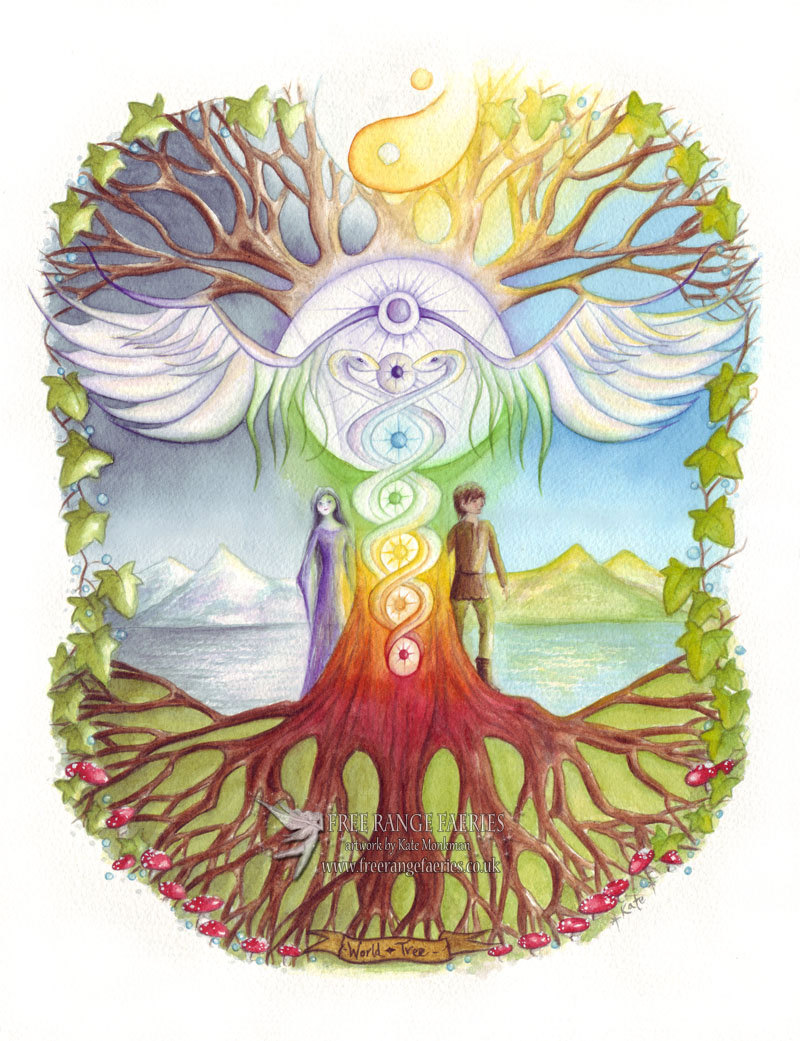
This one is of the Irminsul, which means "great pillar", and indeed is a hidden Yggdrasil / Caduceus / YinYang:
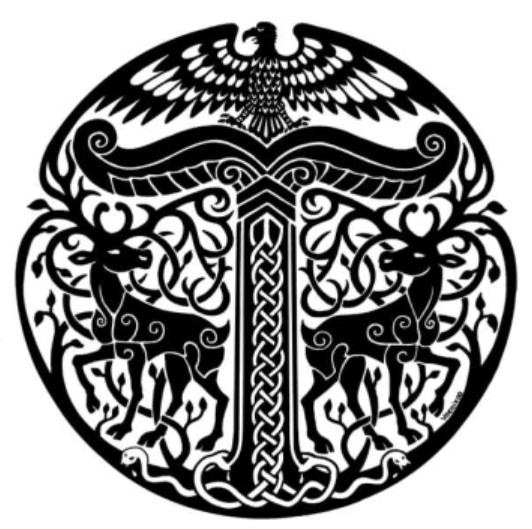
Also note the repeating concept of the Wheel / Circle, which indicates both a cyclical progression as well as the notion that everything is interconnected and can be considered a Whole Singular Entity. The "Holy Whole Hole", if you will.
Ok so now I'll blow your mind and explain something even deeper...
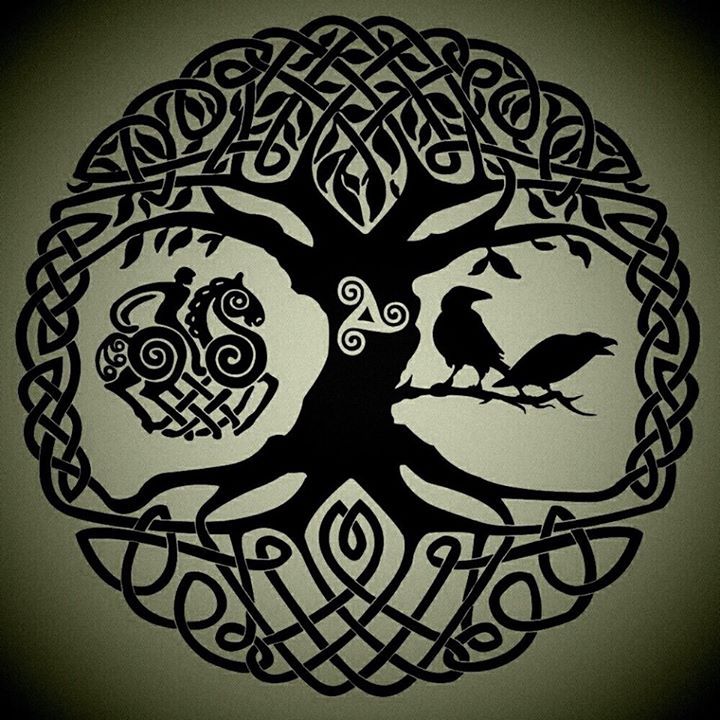
In the above depiction we have Yggdrasil with the Tri in the middle.
To the left we have Odin riding the eight-legged steed Sleipnir across the sky.
8 legs + Odin's 2 arms and legs = 12 btw, which is the Zodiac Wheel.
The 8 is infinity, whereas 8+1 = 9, the completion or perfection of a cycle.
9 is also the number of the realms of existence.
I'll dive deeper into that in the next post...
I mentioned Yggdrasil above kind of randomly, but it was because I brought it up several pages back while referencing the Triskelion, the Valknut, etc. Norse symbols in context of hidden references in language that reveal the occult revelation leading to the apotheosis of Self.
Ok so I stated that Yggdrasil = You. This is 100% correct and the symbolism will reveal that.
For example this is a depiction of Yggdrasil in the context of the Chakras and Yin-Yang:

This one is significant as it integrates the entire concept of the Caduceus.
It retains the Chakras and even depicts the Yin-Yang at the top directly.

This one is of the Irminsul, which means "great pillar", and indeed is a hidden Yggdrasil / Caduceus / YinYang:

Also note the repeating concept of the Wheel / Circle, which indicates both a cyclical progression as well as the notion that everything is interconnected and can be considered a Whole Singular Entity. The "Holy Whole Hole", if you will.
Ok so now I'll blow your mind and explain something even deeper...

In the above depiction we have Yggdrasil with the Tri in the middle.
To the left we have Odin riding the eight-legged steed Sleipnir across the sky.
8 legs + Odin's 2 arms and legs = 12 btw, which is the Zodiac Wheel.
The 8 is infinity, whereas 8+1 = 9, the completion or perfection of a cycle.
9 is also the number of the realms of existence.
I'll dive deeper into that in the next post...
Yggdrasil Mythology
Connects all things.
Evergreen = Eternal
Supports all creation (underlying foundation) = Light
Tree of Life = Yew = You
All is contained within it
Cycle of life death rebirth = 3 spinning in a wheel or spindle, therefore triskelion
The Poetic and Prose Eddas.
It explains Ygg + Drasil = Odin's Horse
Ok so what exactly IS the story of Odin and the World Tree???
He wanted to control Destiny? So he had to learn how to read SYMBOLISM???
By figuring out the symbolism he could use it to spread intentions and alter his Destiny???
So only the 3 Fates could understand the symbols? And they used them to control Destiny??
This is again another reference to the number 3.
Through self-sacrifice and 9 days of torment he was able to learn the symbols.
He 'earned' the knowledge through Honor and Valor.
So in the Tarot card system - this is # 12 the Hanged Man, which is both Odin and or Jesus.
It's about genuine Self-Sacrifice for a greater good.
Here in Crowley's Thoth deck, it even shows the noose around his foot as an Ankh.

In the Holistic deck, it's the Cross of Jesus Christ.
Therefore the Cross = the story of Odin hanging from Yggdrasil.

In this one, we see the world serpent coiling up the tree, and the leaves of the tree can be equivalent of the Crown Chakra 1000 petaled flower.

This indicates a fascinating reversal from highest chakra to lowest chakra, or the ability to face paradoxes and contradictions within one's self and resolve them as a union of opposites.
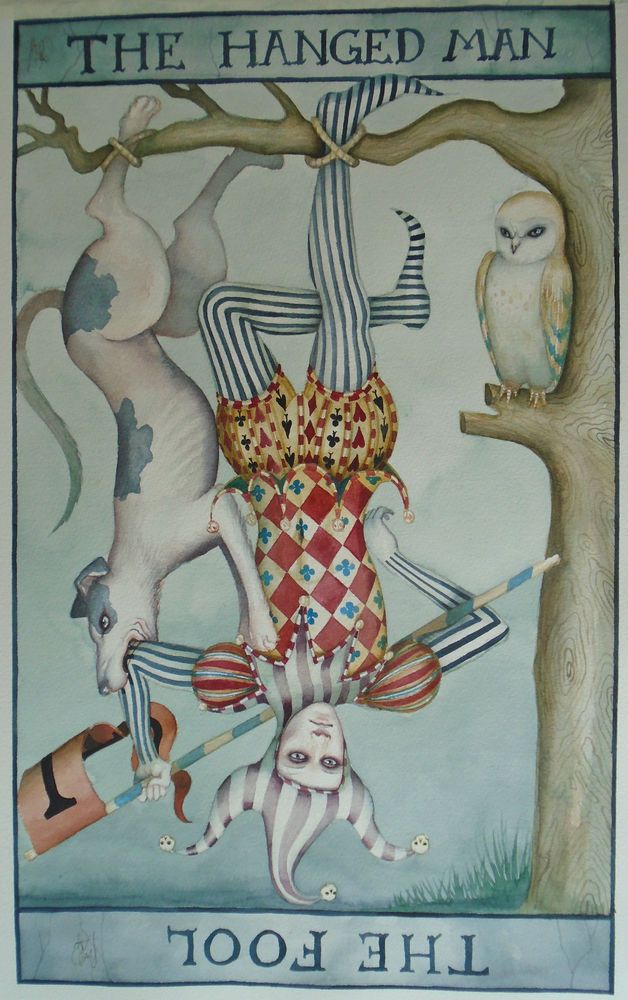
And above, in Dominic Murphy's rendition, the arms and leg are used to create a hidden triskelion, in addition to the 3 points of the jester's cap. The concept of putting "The Fool" on the reverse is to reference us back to the #0 card which indicates childlike innocence and wonder and taking great risks without seeing the consequences. The act of Self-Sacrifice however overturns that foolishness and creates something very Divine.
This is why card #11 is Strength, because it takes Strength to make this complete sacrifice of one's entire self, and why card #13 is Death, because it represents the following Death of Self and the transformation into Spirit that follows.
In Norse mythology Yggdrasil is the name of an enormous glistening ash tree that cradles the nine realms of the cosmos within its branches and roots, thereby connecting all things. The holy tree is evergreen and is covered in moist white loam. It supports all of creation – gods, giants, man, and beasts – some of which eat directly from the branches and roots of the tree. Yggdrasil is also called the World Tree or Tree of Life because it contains all the worlds and represents the cycle of birth, growth, death, and rebirth.
Connects all things.
Evergreen = Eternal
Supports all creation (underlying foundation) = Light
Tree of Life = Yew = You
All is contained within it
Cycle of life death rebirth = 3 spinning in a wheel or spindle, therefore triskelion
The true principles and meanings of the tree, as well as all Old Norse religion and myths, are profound and complex, yet strikingly beautiful.
The two main sources of Norse poems and stories are called the Eddas. They both contain information about the tree of life.
The Poetic and Prose Eddas.
It explains Ygg + Drasil = Odin's Horse
The term Odin’s horse is symbolic for gallows, which pertains to the Norse world tree. The tree served as Odin’s gallows in the poem, Odin’s Rune Song, of the Poetic Edda, in which Odin hung himself on the tree for nine days. The following is an interpretation of the mythological story that links Odin’s gallows to the holy tree.
Ok so what exactly IS the story of Odin and the World Tree???
Odin desired the power to control destiny. But in order to have that control he needed to be able to see and decipher the magic runes, which are a system of symbols that convey wisdom, intention, and power. The runes had the ability to spread intentions across the cosmos through their meanings.
He wanted to control Destiny? So he had to learn how to read SYMBOLISM???
By figuring out the symbolism he could use it to spread intentions and alter his Destiny???
Only the Norns, the three maidens of fate, who lived within the Well of Urd at the bottom of the Norse world tree, understood the runes. The Norns were the controllers of destiny. In order to manifest their desires for all of creation, they would carve the runes into the sacred tree’s trunk. Through the runes, the meanings and intentions of the Norns would travel along the branches and roots of the tree to each of the nine worlds.
So only the 3 Fates could understand the symbols? And they used them to control Destiny??
This is again another reference to the number 3.
To gain the ability to wield the immense power of the runes, Odin had to sacrifice himself. He needed to be worthy of such potent and frightful wisdom. So he stabbed himself and then hung himself from the World Tree for nine days. This was a sacrifice of himself to himself, and only then was he able to obtain the meaning and power of the runes.
Through self-sacrifice and 9 days of torment he was able to learn the symbols.
He 'earned' the knowledge through Honor and Valor.
So in the Tarot card system - this is # 12 the Hanged Man, which is both Odin and or Jesus.
It's about genuine Self-Sacrifice for a greater good.
Here in Crowley's Thoth deck, it even shows the noose around his foot as an Ankh.

In the Holistic deck, it's the Cross of Jesus Christ.
Therefore the Cross = the story of Odin hanging from Yggdrasil.

In this one, we see the world serpent coiling up the tree, and the leaves of the tree can be equivalent of the Crown Chakra 1000 petaled flower.

This indicates a fascinating reversal from highest chakra to lowest chakra, or the ability to face paradoxes and contradictions within one's self and resolve them as a union of opposites.

And above, in Dominic Murphy's rendition, the arms and leg are used to create a hidden triskelion, in addition to the 3 points of the jester's cap. The concept of putting "The Fool" on the reverse is to reference us back to the #0 card which indicates childlike innocence and wonder and taking great risks without seeing the consequences. The act of Self-Sacrifice however overturns that foolishness and creates something very Divine.
This is why card #11 is Strength, because it takes Strength to make this complete sacrifice of one's entire self, and why card #13 is Death, because it represents the following Death of Self and the transformation into Spirit that follows.
Now this artwork is very interesting, I want you to look at it closely...

We have the Eagle at the top, equating to the wings of the Caduceus and also indicating Spiritual flight or freedom or power. We also have the serpent, Odin riding the horse, the Rainbow bridge, etc.
This is another interesting take on it, where it shows Man is his Own Devil.
It also conveys the concept that Lucifer (equated to Satan, the Devil) is the bringer of knowledge but at a price.

Look at the bottom of that last depiction, there is a circle around the head of the hanging man, it has a 9 pointed angled diagram within it.
That is the exact same as the Enneagram of Personality, and are the 9 realms of the Universe.

The 9 pointed star is also the symbol for the Bahá'í Faith, where it represents perfection and Bahá'. In Bahá'í belief the Greatest Name is Bahá’ (بهاء), translated as "glory" or "splendour".
So what does this all mean?
Well, the 100th name is the completion of the cycle, and the 9 personalities or realms of the cosmos are the 9 parts of your psyche (Spirit).
So therefore the "Glory and Splendor of God" = the Completion of YOUR ascension and apotheosis, your culmination of metamorphosis. Your final realization of who you really are. The clinching of "I Am That I Am".
It also represents the MESSENGER and MANIFESTATION of God. Which can be seen as Jesus Christ - but what did Jesus really teach?? To be just like he was, a 'Son of God', and he even said that we are all children of God.
So therefore Jesus is you, just like the Devil is you. Because you are God's emanation into material existence!
That Tree we hung ourselves on is the Tree of Life AND the Tree of Knowledge.
Why is it called the Tree of Knowledge? Know = No.
God pointed at it and said NO! (KNOW)
And you are consuming it's fruit right NOW.

We have the Eagle at the top, equating to the wings of the Caduceus and also indicating Spiritual flight or freedom or power. We also have the serpent, Odin riding the horse, the Rainbow bridge, etc.
This is another interesting take on it, where it shows Man is his Own Devil.
It also conveys the concept that Lucifer (equated to Satan, the Devil) is the bringer of knowledge but at a price.

Look at the bottom of that last depiction, there is a circle around the head of the hanging man, it has a 9 pointed angled diagram within it.
That is the exact same as the Enneagram of Personality, and are the 9 realms of the Universe.

The Enneagram of Personality, or simply the Enneagram (from the Greek words ἐννέα [ennéa, meaning "nine"] and γράμμα [grámma, meaning something "written" or "drawn"[1]]), is a description of the human psyche which is principally understood and taught as a typology of nine interconnected personality types.
The Enneagram of Personality has been widely promoted in both business management and spiritual contexts through seminars, conferences, books, magazines, and DVDs.[3][4] In business contexts, it is generally used as a typology to gain insights into workplace interpersonal-dynamics; in spirituality, it is more commonly presented as a path to higher states of being, essence, and enlightenment. Both contexts claim it can aid in self-awareness, self-understanding and self-development.[3]
The 9 pointed star is also the symbol for the Bahá'í Faith, where it represents perfection and Bahá'. In Bahá'í belief the Greatest Name is Bahá’ (بهاء), translated as "glory" or "splendour".
So what does this all mean?
Well, the 100th name is the completion of the cycle, and the 9 personalities or realms of the cosmos are the 9 parts of your psyche (Spirit).
So therefore the "Glory and Splendor of God" = the Completion of YOUR ascension and apotheosis, your culmination of metamorphosis. Your final realization of who you really are. The clinching of "I Am That I Am".
It also represents the MESSENGER and MANIFESTATION of God. Which can be seen as Jesus Christ - but what did Jesus really teach?? To be just like he was, a 'Son of God', and he even said that we are all children of God.
So therefore Jesus is you, just like the Devil is you. Because you are God's emanation into material existence!
That Tree we hung ourselves on is the Tree of Life AND the Tree of Knowledge.
Why is it called the Tree of Knowledge? Know = No.
God pointed at it and said NO! (KNOW)
And you are consuming it's fruit right NOW.
edit on 3/14/2018 by muzzleflash because: (no reason given)
Ok here's another link to a website called Moksha Productions where it discusses some
information relating to Yggdrasil.
# 12 = Hanged Man and then # 13= Death.
When you Eat of this Tree You will Surely Die, For God knows your eyes will be opened and you will be LIKE GOD????
Ok now let's talk about the YEW Tree and it's association with Yggdrasil.
Or should I call it the YOU Tree???
Ok so another website lists this for Yew Tree symbolism:
It is also the Tree of Resurrection and the Tree of Eternity.
This explains why it is so deeply connected with Yggdrasil and Jesus Christ's Crucifixion.
Immortality, Change, Divinity, Strength are also close connotations.
It's animal is the Eagle, and it's Sabbat is the Winter Solstice.
Goddesstree Yew Symbolism and Lore
It is the Tree of Dreams, Visions, and Hopes.
It represents the Goddess and the Triple aspects, the Trinity.
In Pagan and Norse mythology it is the tree in which Odin, whilst on his quest, hung himself for nine days until he spied the Runes in its branches, and they spoke to him, and gave him wisdom and purpose. In Christian Mythology it is the Tree at the centre of the garden of Eden. The tree from which we were not permitted to eat. The tree in which the whispering serpent spoke to Eve and said ; ".. you will not surely die, For God knows that when you eat of it your eyes will be opened, and you will be like God, knowing good and evil.
# 12 = Hanged Man and then # 13= Death.
When you Eat of this Tree You will Surely Die, For God knows your eyes will be opened and you will be LIKE GOD????
Two very different perspectives of the whispering tree, two very different perspectives on life.
Moksha is liberation. Liberation from duality, splitness and contradiction. In every argument which we can find opposing perspective, there is a greater perspective that unites, the third view, also known as seeing with the third eye.
Yggdrasil, the tree that unites, is the greatest of metaphors for this perspective, its roots in the dark underworld, with the worms, and its branches high in the air with the birds. It unites and bridges the worlds. It is itself the winged serpent, the Dragon with which St George did battle. It represents death and rebirth...
Ok now let's talk about the YEW Tree and it's association with Yggdrasil.
Or should I call it the YOU Tree???
If you visit any church yards in England, Wales, Scotland or Ireland you cannot fail to notice how many of them have an ancient Yew Tree in the cemetery. Nearly all have one, and I believe that if they dont have one now, then it has been cut down. The wardens and priests dont seem to know the resons why all their churches have Yew trees, they say its just traditional, but dont really know why.
Well, its because; The Yew tree IS the tree of life. Our pagan ancestors worshipped these trees.
The Yew tree speaks of eternity, of life within death and rebirth. We need to reconnect with this ancient deity and to listen to the voices on the wind within the branches of the whispering tree.
Ok so another website lists this for Yew Tree symbolism:
As the trunk of the tree begins to decay, a new tree sprouts from the old one. This represents the cycle of life that makes Yew trees a symbol of rebirth as well. However, due to its poisonous nature, it was considered as a symbol of death (associated with funeral and death).
It is also the Tree of Resurrection and the Tree of Eternity.
This explains why it is so deeply connected with Yggdrasil and Jesus Christ's Crucifixion.
Immortality, Change, Divinity, Strength are also close connotations.
It's animal is the Eagle, and it's Sabbat is the Winter Solstice.
Goddesstree Yew Symbolism and Lore
Much of the yew's symbolism is concerned with transcendence, the transformation that arises from death (not necessarily a physical death.)
he Green Man wisdom here is clear - he suggests that if we continue to persevere, the tasks we undertake are more likely to be achieved.
It is the Tree of Dreams, Visions, and Hopes.
It represents the Goddess and the Triple aspects, the Trinity.
the yew is symbolic of the sum of all wisdom. Just as the yew contains the lessons of all the other trees, so, it is said, so we contain all the experiences, knowledge, and understanding of our ancestors.
As the culmination of the spiritual journey, the ultimate lesson of the yew is the transcendence of death.
Ok one more thing before I log out for awhile and call this section on Odin finished, Odin is also shown with 2 Ravens.
Like here:

We will get to the Ravens in more depth later, and as I said several pages ago this thread will be finished with Ravens. So I do hope our member Raven_Heart the Dreamwalker returns to see the finale. We've got a few more sections to go but we are getting close to the end here of my Dream thread.
Ok so the 2 Ravens are Thought and Memory, and are often shown on Odin's shoulders or around him?

There are thousands of pics so you can just Google images search yourself outta curiosity.
The Ravens symbolize many things, but here in this instance I want to reference everyone to our Conscience which is integrated within our Consciousness.
Right vs Wrong, Judgment, Duality of Yin Yang.
Also check this out Amity - Enmity complex
The Angel - Devil on our Shoulders arguing and tempting/warning us, representing Conscience, has been depicted countless times in the last century especially in animated cartoons. Everyone knows this reference and understands exactly what it means.
They understand intuitively that both the Angel and the Demon are not actually separate entities from themselves but are instead actually features of their own psyche and relate a psychological process we all go through. That is why we are held accountable for our actions and we must be responsible for what we decide to do.

Oh yeah, and that's our modern version of the Hangman in a lot of ways, Spidey.
Odin's horse did have 8 legs after all...
And, what is he always doing?
Hanging around looking for another chance to make a Self-Sacrifice to save all of us?

And now that you are gaining power and control over your consciousness in new ways, gaining new abilities and unlocking your innate talents - what message does this Wall-Crawler have to share with us??

Like here:

In Norse mythology, Huginn (from Old Norse "thought") and Muninn (Old Norse "memory" or "mind") are a pair of ravens that fly all over the world, Midgard, and bring information to the god Odin. ... In the Prose Edda and the Third Grammatical Treatise, the two ravens are described as perching on Odin's shoulders.
We will get to the Ravens in more depth later, and as I said several pages ago this thread will be finished with Ravens. So I do hope our member Raven_Heart the Dreamwalker returns to see the finale. We've got a few more sections to go but we are getting close to the end here of my Dream thread.
Ok so the 2 Ravens are Thought and Memory, and are often shown on Odin's shoulders or around him?

There are thousands of pics so you can just Google images search yourself outta curiosity.
The Ravens symbolize many things, but here in this instance I want to reference everyone to our Conscience which is integrated within our Consciousness.
Conscience is an aptitude, faculty, intuition or judgment that assists in distinguishing right from wrong.
Right vs Wrong, Judgment, Duality of Yin Yang.
Also check this out Amity - Enmity complex
Conscience in humans evolved a duality; to protect and save friends, and also to hate and fight enemies.
"[W]e eternally experience the misery... of each new manifestation of the complex, then invent some new 'ism' to categorise this behavior as an evil, dealing with a common behavioural trait piecemeal [instead of] finally grasping and understanding the phenomenon."
The Angel - Devil on our Shoulders arguing and tempting/warning us, representing Conscience, has been depicted countless times in the last century especially in animated cartoons. Everyone knows this reference and understands exactly what it means.
They understand intuitively that both the Angel and the Demon are not actually separate entities from themselves but are instead actually features of their own psyche and relate a psychological process we all go through. That is why we are held accountable for our actions and we must be responsible for what we decide to do.

Oh yeah, and that's our modern version of the Hangman in a lot of ways, Spidey.
Odin's horse did have 8 legs after all...
And, what is he always doing?
Hanging around looking for another chance to make a Self-Sacrifice to save all of us?

And now that you are gaining power and control over your consciousness in new ways, gaining new abilities and unlocking your innate talents - what message does this Wall-Crawler have to share with us??

new topics
-
New job to help stop school shootings
Social Issues and Civil Unrest: 27 minutes ago -
Covid Jab and the Alien Invasion
ATS Skunk Works: 7 hours ago -
Quantum Computer’s, Plasmoid’s, & UAP’s
Aliens and UFOs: 7 hours ago -
Political Warfare & The Resister Special Forces Underground
Political Ideology: 10 hours ago -
Trump Cancel trip to New Jersey because of drones
Aliens and UFOs: 10 hours ago
top topics
-
School shooting in Madison Wi.
Social Issues and Civil Unrest: 15 hours ago, 10 flags -
Prisoner CNN helped free from Syrian prison was actually notorious Assad regime torturer: report
Mainstream News: 17 hours ago, 9 flags -
Political Warfare & The Resister Special Forces Underground
Political Ideology: 10 hours ago, 6 flags -
Covid Jab and the Alien Invasion
ATS Skunk Works: 7 hours ago, 6 flags -
Trump Cancel trip to New Jersey because of drones
Aliens and UFOs: 10 hours ago, 5 flags -
Quantum Computer’s, Plasmoid’s, & UAP’s
Aliens and UFOs: 7 hours ago, 2 flags -
New job to help stop school shootings
Social Issues and Civil Unrest: 27 minutes ago, 1 flags
active topics
-
New job to help stop school shootings
Social Issues and Civil Unrest • 1 • : AlroyFarms -
So this is what Hamas considers 'freedom fighting' ...
War On Terrorism • 294 • : FlyersFan -
Defending the need for adherence to Old Testament commandments under the new covenant of Christ
Conspiracies in Religions • 36 • : ADVISOR -
Russias War Against Religion in Ukraine
World War Three • 10 • : Freeborn -
School shooting in Madison Wi.
Social Issues and Civil Unrest • 43 • : PorkChop96 -
Covid Jab and the Alien Invasion
ATS Skunk Works • 10 • : Dalamax -
Quantum Computer’s, Plasmoid’s, & UAP’s
Aliens and UFOs • 6 • : Dalamax -
Labour Plotting to Postpone May's Council Elections ?
Regional Politics • 5 • : gortex -
Rant. I am sick of people saying the police are revenue raising.
Rant • 15 • : PorkChop96 -
-@TH3WH17ERABB17- -Q- ---TIME TO SHOW THE WORLD--- -Part- --44--
Dissecting Disinformation • 3734 • : duncanagain

